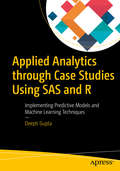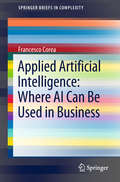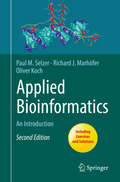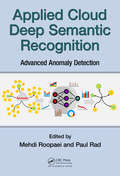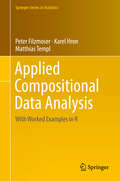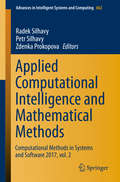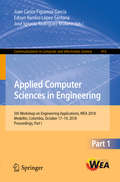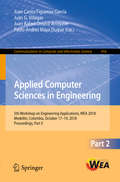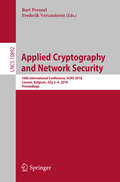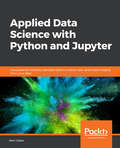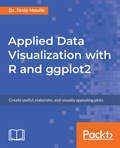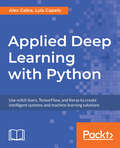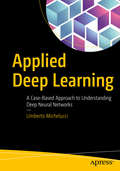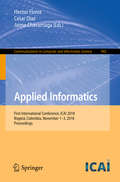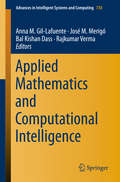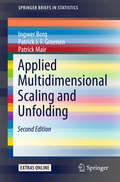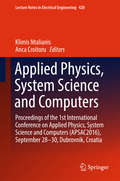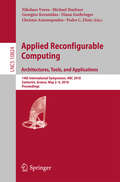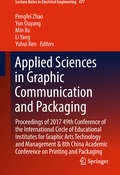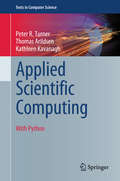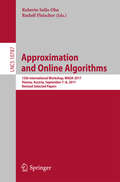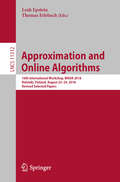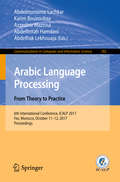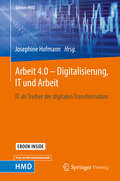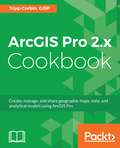- Table View
- List View
Applied Analytics through Case Studies Using SAS and R: Implementing Predictive Models and Machine Learning Techniques
by Deepti GuptaExamine business problems and use a practical analytical approach to solve them by implementing predictive models and machine learning techniques using SAS and the R analytical language. This book is ideal for those who are well-versed in writing code and have a basic understanding of statistics, but have limited experience in implementing predictive models and machine learning techniques for analyzing real world data. The most challenging part of solving industrial business problems is the practical and hands-on knowledge of building and deploying advanced predictive models and machine learning algorithms. Applied Analytics through Case Studies Using SAS and R is your answer to solving these business problems by sharpening your analytical skills. What You'll Learn Understand analytics and basic data concepts Use an analytical approach to solve Industrial business problems Build predictive model with machine learning techniquesCreate and apply analytical strategiesWho This Book Is ForData scientists, developers, statisticians, engineers, and research students with a great theoretical understanding of data and statistics who would like to enhance their skills by getting practical exposure in data modeling.
Applied Artificial Intelligence: Where AI Can Be Used In Business (Springerbriefs In Complexity Ser.)
by Francesco CoreaThis book deals with artificial intelligence (AI) and its several applications. It is not an organic text that should be read from the first page onwards, but rather a collection of articles that can be read at will (or at need). The idea of this work is indeed to provide some food for thoughts on how AI is impacting few verticals (insurance and financial services), affecting horizontal and technical applications (speech recognition and blockchain), and changing organizational structures (introducing new figures or dealing with ethical issues). <P><P> The structure of the chapter is very similar, so I hope the reader won’t find difficulties in establishing comparisons or understanding the differences between specific problems AI is being used for. The first chapter of the book is indeed showing the potential and the achievements of new AI techniques in the speech recognition domain, touching upon the topics of bots and conversational interfaces. The second and thirds chapter tackle instead verticals that are historically data-intensive but not data-driven, i.e., the financial sector and the insurance one. The following part of the book is the more technical one (and probably the most innovative), because looks at AI and its intersection with another exponential technology, namely the blockchain. Finally, the last chapters are instead more operative, because they concern new figures to be hired regardless of the organization or the sector, and ethical and moral issues related to the creation and implementation of new type of algorithms.
Applied Bioinformatics (2nd Edition): An Introduction
by Paul M. Selzer Oliver Koch Richard J. MarhöferThis book introduces readers to the basic principles of bioinformatics and the practical application and utilization of computational tools, without assuming any prior background in programming or informatics. <P><P>It provides a coherent overview of the complex field and focuses on the implementation of online tools, genome databases and software that can benefit scientists and students in the life sciences. Training tutorials with practical bioinformatics exercises and solutions facilitate the understanding and application of such tools and interpretation of results. In addition, a glossary explains terminology that is widely used in the field. This straightforward introduction to applied bioinformatics offers an essential resource for students, as well as scientists seeking to understand the basis of sequencing analysis, functional genomics and protein structure predictions.
Applied Cloud Deep Semantic Recognition: Advanced Anomaly Detection
by Mehdi Roopaei and Paul RadThis book provides a comprehensive overview of the research on anomaly detection with respect to context and situational awareness that aim to get a better understanding of how context information influences anomaly detection. In each chapter, it identifies advanced anomaly detection and key assumptions, which are used by the model to differentiate between normal and anomalous behavior. When applying a given model to a particular application, the assumptions can be used as guidelines to assess the effectiveness of the model in that domain. Each chapter provides an advanced deep content understanding and anomaly detection algorithm, and then shows how the proposed approach is deviating of the basic techniques. Further, for each chapter, it describes the advantages and disadvantages of the algorithm. The final chapters provide a discussion on the computational complexity of the models and graph computational frameworks such as Google Tensorflow and H2O because it is an important issue in real application domains. This book provides a better understanding of the different directions in which research has been done on deep semantic analysis and situational assessment using deep learning for anomalous detection, and how methods developed in one area can be applied in applications in other domains. This book seeks to provide both cyber analytics practitioners and researchers an up-to-date and advanced knowledge in cloud based frameworks for deep semantic analysis and advanced anomaly detection using cognitive and artificial intelligence (AI) models.
Applied Compositional Data Analysis: With Worked Examples In R (Springer Series in Statistics)
by Peter Filzmoser Matthias Templ Karel HronThis book presents the statistical analysis of compositional data using the log-ratio approach. It includes a wide range of classical and robust statistical methods adapted for compositional data analysis, such as supervised and unsupervised methods like PCA, correlation analysis, classification and regression. In addition, it considers special data structures like high-dimensional compositions and compositional tables. The methodology introduced is also frequently compared to methods which ignore the specific nature of compositional data. It focuses on practical aspects of compositional data analysis rather than on detailed theoretical derivations, thus issues like graphical visualization and preprocessing (treatment of missing values, zeros, outliers and similar artifacts) form an important part of the book. Since it is primarily intended for researchers and students from applied fields like geochemistry, chemometrics, biology and natural sciences, economics, and social sciences, all the proposed methods are accompanied by worked-out examples in R using the package robCompositions.
Applied Computational Intelligence and Mathematical Methods: Computational Methods in Systems and Software 2017, vol. 2 (Advances in Intelligent Systems and Computing #662)
by Radek Silhavy Petr Silhavy Zdenka ProkopovaThe book discusses real-world problems and exploratory research in computational intelligence and mathematical models. It brings new approaches and methods to real-world problems and exploratory research that describes novel approaches in the mathematical methods, computational intelligence methods and software engineering in the scope of the intelligent systems. This book constitutes the refereed proceedings of the Computational Methods in Systems and Software 2017, a conference that provided an international forum for the discussion of the latest high-quality research results in all areas related to computational methods, statistics, cybernetics and software engineering.
Applied Computer Sciences in Engineering: 5th Workshop on Engineering Applications, WEA 2018, Medellín, Colombia, October 17-19, 2018, Proceedings, Part I (Communications in Computer and Information Science #915)
by Juan Carlos Figueroa-García Eduyn Ramiro López-Santana José Ignacio Rodriguez-MolanoThis two-volume set (CCIS 915 and CCIS 916) constitutes the refereed proceedings of the 5th Workshop on Engineering Applications, WEA 2018, held in Medellín, Colombia, in October 2018. The 50 revised full papers presented in this volume were carefully reviewed and selected from126 submissions. The papers are organized in topical sections such as computer science; computational intelligence; simulation systems; software engineering; power and energy applications.
Applied Computer Sciences in Engineering: 5th Workshop on Engineering Applications, WEA 2018, Medellín, Colombia, October 17-19, 2018, Proceedings, Part II (Communications in Computer and Information Science #916)
by Juan Carlos Figueroa-García Juan G. Villegas Juan Rafael Orozco-Arroyave Pablo Andres Maya DuqueThis two-volume set (CCIS 915 and CCIS 916) constitutes the refereed proceedings of the 5th Workshop on Engineering Applications, WEA 2018, held in Medellín, Colombia, in October 2018. The 41 revised full papers presented in this volume were carefully reviewed and selected from 101 submissions. The papers are organized in topical sections such as green logistics and optimization, Internet of Things (IoT), digital signal processing (DSP), network applications, miscellaneous applications.
Applied Cryptography and Network Security: 16th International Conference, ACNS 2018, Leuven, Belgium, July 2-4, 2018, Proceedings (Lecture Notes in Computer Science #10892)
by Bart Preneel Frederik VercauterenThis book constitutes the refereed proceedings of the 16th International Conference on on Applied Cryptography and Network Security, ACNS 2018, held in Leuven, Belgium, in July 2018. The 36 revised full papers presented were carefully reviewed and selected from 173 submissions. The papers were organized in topical sections named: Cryptographic Protocols; Side Channel Attacks and Tamper Resistance; Digital Signatures; Privacy Preserving Computation; Multi-party Computation; Symmetric Key Primitives; Symmetric Key Primitives; Symmetric Key Cryptanalysis; Public Key Encryption; Authentication and Biometrics; Cloud and Peer-to-peer Security.
Applied Data Science with Python and Jupyter: Use powerful industry-standard tools to unlock new, actionable insights from your data
by Alex GaleaBecome the master player of data exploration by creating reproducible data processing pipelines, visualizations, and prediction models for your applications.Key FeaturesGet up and running with the Jupyter ecosystem and some example datasetsLearn about key machine learning concepts such as SVM, KNN classifiers, and Random ForestsDiscover how you can use web scraping to gather and parse your own bespoke datasetsBook DescriptionGetting started with data science doesn't have to be an uphill battle. Applied Data Science with Python and Jupyter is a step-by-step guide ideal for beginners who know a little Python and are looking for a quick, fast-paced introduction to these concepts. In this book, you'll learn every aspect of the standard data workflow process, including collecting, cleaning, investigating, visualizing, and modeling data. You'll start with the basics of Jupyter, which will be the backbone of the book. After familiarizing ourselves with its standard features, you'll look at an example of it in practice with our first analysis. In the next lesson, you dive right into predictive analytics, where multiple classification algorithms are implemented. Finally, the book ends by looking at data collection techniques. You'll see how web data can be acquired with scraping techniques and via APIs, and then briefly explore interactive visualizations.What you will learnGet up and running with the Jupyter ecosystemIdentify potential areas of investigation and perform exploratory data analysisPlan a machine learning classification strategy and train classification modelsUse validation curves and dimensionality reduction to tune and enhance your modelsScrape tabular data from web pages and transform it into Pandas DataFramesCreate interactive, web-friendly visualizations to clearly communicate your findingsWho this book is forApplied Data Science with Python and Jupyter is ideal for professionals with a variety of job descriptions across a large range of industries, given the rising popularity and accessibility of data science. You'll need some prior experience with Python, with any prior work with libraries such as Pandas, Matplotlib, and Pandas providing you a useful head start.
Applied Data Visualization with R and ggplot2: Create useful, elaborate, and visually appealing plots
by Dr Tania MoulikDevelop informative and aesthetic visualizations that enable effective data analysis in less timeKey FeaturesDiscover structure of ggplot2, grammar of graphics, and geometric objectsStudy how to design and implement visualization from scratchExplore the advantages of using advanced plotsBook DescriptionApplied Data Visualization with R and ggplot2 introduces you to the world of data visualization by taking you through the basic features of ggplot2. To start with, you’ll learn how to set up the R environment, followed by getting insights into the grammar of graphics and geometric objects before you explore the plotting techniques.You’ll discover what layers, scales, coordinates, and themes are, and study how you can use them to transform your data into aesthetical graphs. Once you’ve grasped the basics, you’ll move on to studying simple plots such as histograms and advanced plots such as superimposing and density plots. You’ll also get to grips with plotting trends, correlations, and statistical summaries.By the end of this book, you’ll have created data visualizations that will impress your clients.What you will learnSet up the R environment, RStudio, and understand structure of ggplot2Distinguish variables and use best practices to visualize themChange visualization defaults to reveal more information about dataImplement the grammar of graphics in ggplot2 such as scales and facetingBuild complex and aesthetic visualizations with ggplot2 analysis methodsLogically and systematically explore complex relationshipsCompare variables in a single visual, with advanced plotting methodsWho this book is forApplied Data Visualization with R and ggplot2 is for you if you are a professional working with data and R. This book is also for students who want to enhance their data analysis skills by adding informative and professional visualizations. It is assumed that you know basics of the R language and its commands and objects.
Applied Deep Learning with Python: Use scikit-learn, TensorFlow, and Keras to create intelligent systems and machine learning solutions
by Luis Capelo Alex GaleaA hands-on guide to deep learning that’s filled with intuitive explanations and engaging practical examplesKey FeaturesDesigned to iteratively develop the skills of Python users who don’t have a data science backgroundCovers the key foundational concepts you’ll need to know when building deep learning systemsFull of step-by-step exercises and activities to help build the skills that you need for the real-worldBook DescriptionTaking an approach that uses the latest developments in the Python ecosystem, you’ll first be guided through the Jupyter ecosystem, key visualization libraries and powerful data sanitization techniques before we train our first predictive model. We’ll explore a variety of approaches to classification like support vector networks, random decision forests and k-nearest neighbours to build out your understanding before we move into more complex territory. It’s okay if these terms seem overwhelming; we’ll show you how to put them to work.We’ll build upon our classification coverage by taking a quick look at ethical web scraping and interactive visualizations to help you professionally gather and present your analysis. It’s after this that we start building out our keystone deep learning application, one that aims to predict the future price of Bitcoin based on historical public data.By guiding you through a trained neural network, we’ll explore common deep learning network architectures (convolutional, recurrent, generative adversarial) and branch out into deep reinforcement learning before we dive into model optimization and evaluation. We’ll do all of this whilst working on a production-ready web application that combines Tensorflow and Keras to produce a meaningful user-friendly result, leaving you with all the skills you need to tackle and develop your own real-world deep learning projects confidently and effectively.What you will learnDiscover how you can assemble and clean your very own datasetsDevelop a tailored machine learning classification strategyBuild, train and enhance your own models to solve unique problemsWork with production-ready frameworks like Tensorflow and KerasExplain how neural networks operate in clear and simple termsUnderstand how to deploy your predictions to the webWho this book is forIf you're a Python programmer stepping into the world of data science, this is the ideal way to get started.
Applied Deep Learning: A Case-Based Approach to Understanding Deep Neural Networks
by Umberto MichelucciWork with advanced topics in deep learning, such as optimization algorithms, hyper-parameter tuning, dropout, and error analysis as well as strategies to address typical problems encountered when training deep neural networks. You’ll begin by studying the activation functions mostly with a single neuron (ReLu, sigmoid, and Swish), seeing how to perform linear and logistic regression using TensorFlow, and choosing the right cost function. The next section talks about more complicated neural network architectures with several layers and neurons and explores the problem of random initialization of weights. An entire chapter is dedicated to a complete overview of neural network error analysis, giving examples of solving problems originating from variance, bias, overfitting, and datasets coming from different distributions. Applied Deep Learning also discusses how to implement logistic regression completely from scratch without using any Python library except NumPy, to let you appreciate how libraries such as TensorFlow allow quick and efficient experiments. Case studies for each method are included to put into practice all theoretical information. You’ll discover tips and tricks for writing optimized Python code (for example vectorizing loops with NumPy). What You Will LearnImplement advanced techniques in the right way in Python and TensorFlowDebug and optimize advanced methods (such as dropout and regularization)Carry out error analysis (to realize if one has a bias problem, a variance problem, a data offset problem, and so on)Set up a machine learning project focused on deep learning on a complex datasetWho This Book Is ForReaders with a medium understanding of machine learning, linear algebra, calculus, and basic Python programming.
Applied Informatics: First International Conference, ICAI 2018, Bogotá, Colombia, November 1-3, 2018, Proceedings (Communications in Computer and Information Science #942)
by Hector Florez Cesar Diaz Jaime ChavarriagaThis book constitutes the thoroughly refereed papers of the First International Conference on Applied Informatics, ICAI 2018, held in Bogotá, Colombia, in November 2018. The 27 full papers were carefully reviewed and selected from 81 submissions. The papers are organized in topical sections on data analysis; decision systems; health care information systems; IT architectures; learning management systems; mobile information processing systems; robotic autonomy; software design engineering.
Applied Mathematics and Computational Intelligence (Advances In Intelligent Systems And Computing #730)
by José M. Merigó Anna M. Gil-Lafuente Bal Kishan Dass Rajkumar VermaThis book gathers selected papers presented at the conference of the Forum for Interdisciplinary Mathematics (FIM), held at Palau Macaya, Barcelona, on 18 to 20 November, 2015. The event was co-organized by the University of Barcelona (Spain), the Spanish Royal Academy of Economic and Financial Sciences (Spain) and the Forum for Interdisciplinary Mathematics (India).
Applied Multidimensional Scaling and Unfolding (SpringerBriefs In Statistics)
by Ingwer Borg Patrick J.F. Groenen Patrick MairProvides a concise, largely conceptual introduction to multidimensional scaling and unfolding.<p><p> Focuses on how to actually run and interpret MDS and unfolding in applied research (with examples from psychology, the social sciences, and market research).<p> Explains with several examples how to use the R-package smacof for MDS/unfolding and Proxscal in SPSS.<p> Includes numerous R-scripts that show how to run MDS and unfolding analyses (a file containing all scripts, and more, can be downloaded).<p>This book introduces multidimensional scaling (MDS) and unfolding as data analysis techniques for applied researchers. MDS is used for the analysis of proximity data on a set of objects, representing the data as distances between points in a geometric space (usually of two dimensions). Unfolding is a related method that maps preference data (typically evaluative ratings of different persons on a set of objects) as distances between two sets of points (representing the persons and the objects, resp.).<p> This second edition has been completely revised to reflect new developments and the coverage of unfolding has also been substantially expanded. Intended for applied researchers whose main interests are in using these methods as tools for building substantive theories, it discusses numerous applications (classical and recent), highlights practical issues (such as evaluating model fit), presents ways to enforce theoretical expectations for the scaling solutions, and addresses the typical mistakes that MDS/unfolding users tend to make. Further, it shows how MDS and unfolding can be used in practical research work, primarily by using the smacof package in the R environment but also Proxscal in SPSS. It is a valuable resource for psychologists, social scientists, and market researchers, with a basic understanding of multivariate statistics (such as multiple regression and factor analysis).
Applied Physics, System Science and Computers: Proceedings of the 1st International Conference on Applied Physics, System Science and Computers (APSAC2016), September 28-30, Dubrovnik, Croatia (Lecture Notes in Electrical Engineering #428)
by Klimis Ntalianis Anca CroitoruThis book reports on advanced theories and methods in three related fields of research: applied physics, system science and computers. It is organized in two main parts, the first of which covers applied physics topics, including lasers and accelerators; condensed matter, soft matter and materials science; nanoscience and quantum engineering; atomic, molecular, optical and plasma physics; as well as nuclear and high-energy particle physics. It also addresses astrophysics, gravitation, earth and environmental science, as well as medical and biological physics. The second part focuses on advances in system science and computers, exploring automatic circuit control, power systems, computer communication, fluid mechanics, simulation and modeling, software engineering, data structures and applications of artificial intelligence among other areas. Offering a collection of contributions presented at the 1st International Conference on Applied Physics, System Science and Computers (APSAC 2016), the book bridges the gap between applied physics and electrical engineering. It not only to presents new methods, but also promotes collaborations between different communities working on related topics at the interface between physics and engineering, with a special focus on communication, data modeling and visualization, quantum information, applied mechanics as well as bio and geophysics.
Applied Reconfigurable Computing. Architectures, Tools, and Applications: 14th International Symposium, Arc 2018, Santorini, Greece, May 2-4, 2018, Proceedings (Lecture Notes In Computer Science #10824)
by Pedro C. Diniz Diana Goehringer Michael Huebner Nikolaos Voros Georgios Keramidas Christos AntonopoulosThis book constitutes the proceedings of the 14th International Conference on Applied Reconfigurable Computing, ARC 2018, held in Santorini, Greece, in May 2018. <P><P> The 29 full papers and 22 short presented in this volume were carefully reviewed and selected from 78 submissions. In addition, the volume contains 9 contributions from research projects. The papers were organized in topical sections named: machine learning and neural networks; FPGA-based design and CGRA optimizations; applications and surveys; fault-tolerance, security and communication architectures; reconfigurable and adaptive architectures; design methods and fast prototyping; FPGA-based design and applications; and special session: research projects.
Applied Sciences in Graphic Communication and Packaging: Proceedings of 2017 49th Conference of the International Circle of Educational Institutes for Graphic Arts Technology and Management & 8th China Academic Conference on Printing and Packaging (Lecture Notes in Electrical Engineering #477)
by Min Xu Li Yang Yun Ouyang Pengfei Zhao Yuhui RenThis book includes a selection of reviewed papers presented at the 49th Conference of the International Circle of Educational Institutes for Graphic Arts Technology and Management & 8th China Academic Conference on Printing and Packaging, which was held on May 14-16, 2017 in Beijing, China. The conference was jointly organized by the Beijing Institute of Graphic Communication, China Academy of Printing Technology, and International Circle of Educational Institutes for Graphic Arts Technology and Management. With eight keynote talks and 200 presented papers on graphic communication and packaging technologies, the event attracted more than 400 scientists. The proceedings cover the latest advances in color science and technology; image processing technology; digital media technology; digital process management technology in packaging; packaging, etc. , and will be of interest to university researchers, R&D engineers and graduate students in the graphic arts, packaging, color science, image science, material science, computer science, digital media and network technology.
Applied Scientific Computing: With Python (Texts in Computer Science)
by Peter R. Turner Thomas Arildsen Kathleen KavanaghThis easy-to-understand textbook presents a modern approach to learning numerical methods (or scientific computing), with a unique focus on the modeling and applications of the mathematical content. Emphasis is placed on the need for, and methods of, scientific computing for a range of different types of problems, supplying the evidence and justification to motivate the reader. Practical guidance on coding the methods is also provided, through simple-to-follow examples using Python.Topics and features: provides an accessible and applications-oriented approach, supported by working Python code for many of the methods; encourages both problem- and project-based learning through extensive examples, exercises, and projects drawn from practical applications; introduces the main concepts in modeling, python programming, number representation, and errors; explains the essential details of numerical calculus, linear, and nonlinear equations, including the multivariable Newton method; discusses interpolation and the numerical solution of differential equations, covering polynomial interpolation, splines, and the Euler, Runge–Kutta, and shooting methods; presents largely self-contained chapters, arranged in a logical order suitable for an introductory course on scientific computing.Undergraduate students embarking on a first course on numerical methods or scientific computing will find this textbook to be an invaluable guide to the field, and to the application of these methods across such varied disciplines as computer science, engineering, mathematics, economics, the physical sciences, and social science.
Approximation and Online Algorithms: 15th International Workshop, WAOA 2017, Vienna, Austria, September 7–8, 2017, Revised Selected Papers (Lecture Notes in Computer Science #10787)
by Rudolf Fleischer Roberto Solis-ObaThis book constitutes the thoroughly refereed workshop post-proceedings of the 15th International Workshop on Approximation and Online Algorithms, WAOA 2017, held in Vienna, Austria, in September 2017 as part of ALGO 2017.The 23 revised full papers presented in this book were carefully reviewed and selected from 50 submissions. Topics of interest for WAOA 2017 were: graph algorithms; inapproximability results; network design; packing and covering; paradigms for the design and analysis of approximation and online algorithms; parameterized complexity; scheduling problems; algorithmic game theory; coloring and partitioning; competitive analysis; computational advertising; computational finance; cuts and connectivity; geometric problems; mechanism design; resource augmentation; and real-world applications.
Approximation and Online Algorithms: 16th International Workshop, WAOA 2018, Helsinki, Finland, August 23-24, 2018, Revised Selected Papers (Lecture Notes in Computer Science #11312)
by Leah Epstein Thomas ErlebachThis book constitutes the thoroughly refereed workshop post-proceedings of the 16th International Workshop on Approximation and Online Algorithms, WAOA 2018, held in Helsinki, Finland, in August 2018 as part of ALGO 2018. The 19 revised full papers presented together with one invited paper in this book were carefully reviewed and selected from 44 submissions. Topics of interest for WAOA 2016 were: graph algorithms; inapproximability results; network design; packing and covering; paradigms for the design and analysis of approximation and online algorithms; parameterized complexity; scheduling problems; algorithmic game theory; algorithmic trading; coloring and partitioning; competitive analysis; computational advertising; computational finance; cuts and connectivity; geometric problems; mechanism design; resource augmentation; and real-world applications.
Arabic Language Processing: 6th International Conference, ICALP 2017, Fez, Morocco, October 11–12, 2017, Proceedings (Communications in Computer and Information Science #782)
by Abdelmonaime Lachkar Karim Bouzoubaa Azzedine Mazroui Abdelfettah Hamdani Abdelhak LekhouajaThis book constitutes revised selected papers from the 6th International Conference on Arabic Language Processing, ICALP 2017, held in Fez, Morocco, in October 2017. The 18 full papers presented in this volume were carefully reviewed and selected from 55 submissions. They were organized in topical sections named: machine translation systems; speech recognition and synthesis; text categorization, clustering and summarization; information retrieval systems; and Arabic NLP tools and applications.
Arbeit 4.0 – Digitalisierung, IT und Arbeit: It Als Treiber Der Digitalen Transformation (Edition HMD)
by Josephine HofmannAktuelle und spannende Fachbeiträge zur Arbeitswelt der Zukunft.<P><P> Diskutiert Arbeitsgestaltung und Qualifizierung im Zeitalter der Digitalisierung.<P> Liefert differenzierte Einblicke zu IT-Einsatz und Wirkung in verschiedenen Branchen.<P> Die Digitalisierung transformiert die Arbeitswelt in vieler Hinsicht: Arbeitsplätze werden zunehmend mobil und flexibel, Arbeitsprozesse durch Algorithmen gesteuert, Roboter sind die neuen „Kollegen“ in der Industrie und im Dienstleistungssektor. Dieser Band der „Edition HDM“ erörtert viele zentrale Fragen rund um die Transformation der Arbeitswelt von heute und morgen. In ihren Beiträgen über den Einfluss der massiven Digitalisierung auf unterschiedliche Branchen und Arbeitsbereiche diskutieren die Autorinnen und Autoren diverse Aspekte wie: • den Einfluss der Digitalisierung im Versandhandel und auf die Wissensarbeit. • die Interaktion von Mensch und Roboter in der Fabrik 4.0.• den Wert der menschlichen Arbeitsleistung in der Zukunft.• die Anforderungen an Qualifizierung.• die Möglichkeiten für Mitarbeiter, die Arbeit in der vernetzten Wirtschaft 4.0 proaktiv mitzugestalten. Unter der Herausgeberschaft von Josephine Hofmann, Leiterin des Competence Center Business Performance Management am Fraunhofer IAO in Stuttgart, entsteht so ein Sammelband, der sich als Teil der aktuellen Debatte um die digitale Transformation der Arbeitswelt versteht. Nicht nur Wissenschaftler erhalten neue Denkanstöße für ihre Forschung, auch Entscheider in Wirtschaft und Politik sowie Verantwortliche in den Bereichen Bildung, Fortbildung und Personalentwicklung können aus der Lektüre des Buches wertvolle Erkenntnisse über die Arbeit von heute und die Gestaltung der zunehmend digitalisierten Arbeitswelt von morgen gewinnen.
ArcGIS Pro 2.x Cookbook: Create, manage, and share geographic maps, data, and analytical models using ArcGIS Pro
by Tripp CorbinCreating and Sharing Maps and Data using ArcGIS Pro Key Features Leverage the power of ArcGIS to build beautiful 2D and 3D maps. Work with ArcGIS to analyze and process data. Extend the power of ArcGIS to ArcGIS Online to create and edit content. Book Description ArcGIS is Esri's catalog of GIS applications with powerful tools for visualizing, maintaining, and analyzing data. ArcGIS makes use of the modern ribbon interface and 64-bit processing to increase the speed and efficiency of using GIS. It allows users to create amazing maps in both 2D and 3D quickly and easily. If you want to gain a thorough understanding of the various data formats that can be used in ArcGIS Pro and shared via ArcGIS Online, then this book is for you. Beginning with a refresher on ArcGIS Pro and how to work with projects, this book will quickly take you through recipes about using various data formats supported by the tool. You will learn the limits of each format, such as Shapefiles, Geodatabase, and CAD files, and learn how to link tables from outside sources to existing GIS data to expand the amount of data that can be used in ArcGIS. You'll learn methods for editing 2D and 3D data using ArcGIS Pro and how topology can be used to ensure data integrity. Lastly the book will show you how data and maps can be shared via ArcGIS Online and used with web and mobile applications. What you will learn Edit data using standard tools and topology Convert and link data together using joins and relates Create and share data using Projections and Coordinate Systems Access and collect data in the field using ArcGIS Collector Perform proximity analysis and map clusters with hotspot analysis Use the 3D Analyst Extension and perform advanced 3D analysis Share maps and data using ArcGIS Online via web and mobile apps Who this book is for GIS developers who are comfortable using ArcGIS, and are looking to increase their capabilities and skills, will find this book useful.
